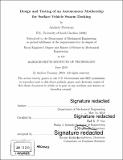| dc.contributor.advisor | Dick K. P. Yue. | en_US |
| dc.contributor.author | Freeman, Andrew(Andrew John) | en_US |
| dc.contributor.other | Massachusetts Institute of Technology. Department of Mechanical Engineering. | en_US |
| dc.date.accessioned | 2019-09-17T22:44:31Z | |
| dc.date.available | 2019-09-17T22:44:31Z | |
| dc.date.copyright | 2019 | en_US |
| dc.date.issued | 2019 | en_US |
| dc.date.issued | 2019 | en_US |
| dc.identifier.uri | https://hdl.handle.net/1721.1/122263 | |
| dc.description | Thesis: Nav. E., Massachusetts Institute of Technology, Department of Mechanical Engineering, 2019 | en_US |
| dc.description | Thesis: S.M., Massachusetts Institute of Technology, Department of Mechanical Engineering, 2019 | en_US |
| dc.description | Cataloged from PDF version of thesis. | en_US |
| dc.description | Includes bibliographical references (pages 129-131). | en_US |
| dc.description.abstract | The field of marine autonomous systems has blossomed over the past several decades yet much remains to be explored. One important focus area gaining increased attention in this domain is the understanding and development of cooperative groups of vessels, known as swarms. Using simple behavioral rule sets, these systems of marine vehicles can work together in many ways including traveling in a "flock" or forming a perimeter around an area of interest. In many cases, however, the vehicles encounter limitations with respect to their capacity to carry a certain resource. This can manifest itself in the form of finite electrical energy, cargo-carrying capacity, or the need to replenish a swarm vehicle's deployable payloads. In all of these situations, there are many useful scenarios where the addition of a "mothership" can improve overall system performance. This thesis elucidates the essential parameters for the design of such a mothership and considerations for docking the two vehicles together autonomously. Focus is placed on maintaining the mothership lightweight, compact, and low cost to ensure the results are usable by a broad audience and that the principles are shown to apply to the widest array of designs. A methodology and tools are presented herein to prepare future designers for creating similar systems. These include a theoretical analysis of the finite resource problem and how to leverage parameter relationships to determine design specifications for the mothership. A computational analysis of mother-daughter relative motions in waves follows which validates that the hullform characteristics support reduced complexity at the docking bay. Finally, a prototype developed by the author using the proposed methodology is detailed and experimental results are presented which highlight important considerations contributing to the success of autonomous mothership docking. | en_US |
| dc.description.statementofresponsibility | by Andrew Freeman. | en_US |
| dc.format.extent | 131 pages | en_US |
| dc.language.iso | eng | en_US |
| dc.publisher | Massachusetts Institute of Technology | en_US |
| dc.rights | MIT theses are protected by copyright. They may be viewed, downloaded, or printed from this source but further reproduction or distribution in any format is prohibited without written permission. | en_US |
| dc.rights.uri | http://dspace.mit.edu/handle/1721.1/7582 | en_US |
| dc.subject | Mechanical Engineering. | en_US |
| dc.title | Design and testing of an autonomous mothership for surface vehicle swarm docking | en_US |
| dc.type | Thesis | en_US |
| dc.description.degree | Nav. E. | en_US |
| dc.description.degree | S.M. | en_US |
| dc.contributor.department | Massachusetts Institute of Technology. Department of Mechanical Engineering | en_US |
| dc.identifier.oclc | 1117714217 | en_US |
| dc.description.collection | Nav.E. Massachusetts Institute of Technology, Department of Mechanical Engineering | en_US |
| dc.description.collection | S.M. Massachusetts Institute of Technology, Department of Mechanical Engineering | en_US |
| dspace.imported | 2019-09-17T22:44:31Z | en_US |
| mit.thesis.degree | Engineer | en_US |
| mit.thesis.department | MechE | en_US |
